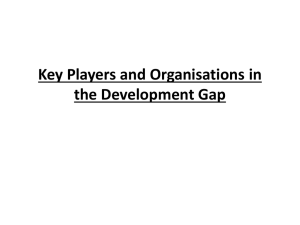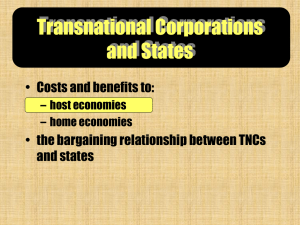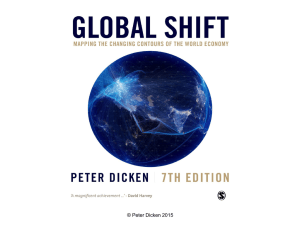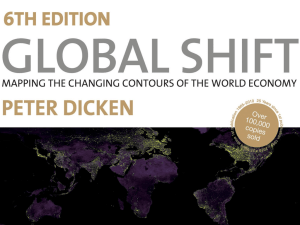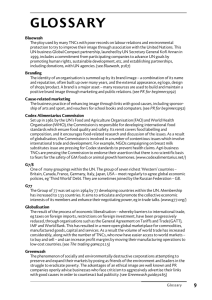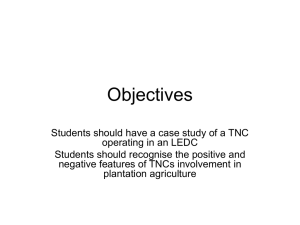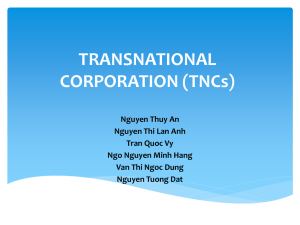Cultural Dilemmas of International Management
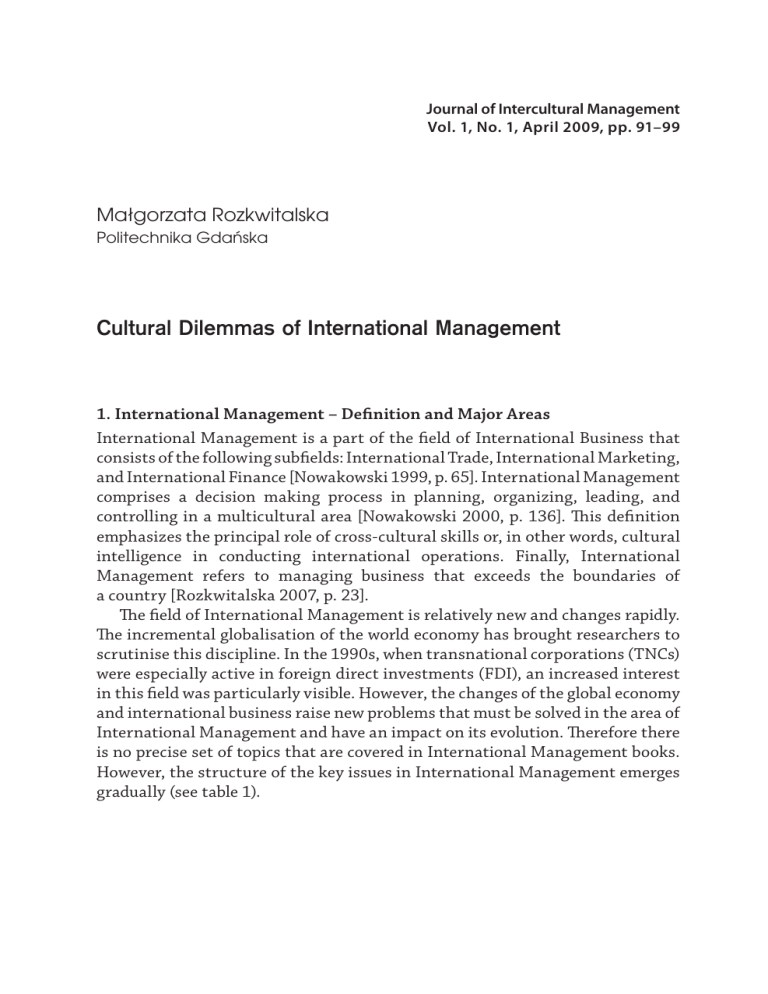
Journal of Intercultural Management
Vol. 1, No. 1, April 2009, pp. 91–99
Małgorzata Rozkwitalska
Politechnika Gdańska
Cultural Dilemmas of International Management
1. International Management – Definition and Major Areas
International Management is a part of the field of International Business that consists of the following subfields: International Trade, International Marketing, and International Finance [Nowakowski 1999, p. 65]. International Management comprises a decision making process in planning, organizing, leading, and controlling in a multicultural area [Nowakowski 2000, p. 136]. This definition emphasizes the principal role of cross-cultural skills or, in other words, cultural intelligence in conducting international operations. Finally, International
Management refers to managing business that exceeds the boundaries of a country [Rozkwitalska 2007, p. 23].
The field of International Management is relatively new and changes rapidly.
The incremental globalisation of the world economy has brought researchers to scrutinise this discipline. In the 1990s, when transnational corporations (TNCs) were especially active in foreign direct investments (FDI), an increased interest in this field was particularly visible. However, the changes of the global economy and international business raise new problems that must be solved in the area of
International Management and have an impact on its evolution. Therefore there is no precise set of topics that are covered in International Management books.
However, the structure of the key issues in International Management emerges gradually (see table 1).
92 Małgorzata Rozkwitalska
Table 1.
International Management – an overview of the key issues.
Handbook
Key issues
Handbook
Key issues
Handbook
Key issues
Handbook
Key issues
Handbook
Key issues
McFarlin, S.B., Sweeney, P.D. 2006, International Management. Strategic
Opportunities and Cultural Challenges , Houghton Mifflin Company,
Boston, New York.
I. On a Global stage: The Context of International Management
II. Interacting Effectively in an International Environment
III. Capitalizing on International Opportunities
IV. Managing People in International Arena
Phatak, A.V., Bhagat, R.S., Kashlak, R.J. 2004, International Management:
Managing in a Diverse and Dynamic Global Environment , McGraw Hill,
New York.
I. International Environment
II. Managing International Strategy Planning and Strategy
Implementation
III. Cross-cultural Managing of People and Processes
IV. Ethics in International Management
Koźmiński, A.K. 1999, Zarządzanie międzynarodowe , PWE, Warszawa.
I. Internationalisation and globalisation
II. New Sources of Competitive Advantage
III. Strategies and Structures in International Management
IV. Internationalisation of Value Added Chain
V. Integration and Coordination of Value Added Chain in Multinationals
VI. Internationalisation of Polish Enterprises
Nowakowski, M.K. 1999, Wprowadzenie do zarządzania międzynarodowego , Difin, Warszawa.
I. Essence of International Management
II. International Management and Business Philosophy
III. Cross-cultural Management
IV. Human Resources Management in International Area
V. International Entrepreneurship
VI. Polish Priorities in International Management
Rozkwitalska, M. 2007, Zarządzanie międzynarodowe , Diffin, Warszawa.
I. International Environment – Conditions for International
Management
II. Internationalisation Process
III. Managing in Transnational Corporations
IV. Strategies and Structures of International Management
Sources : adapted from Rozkwitalska 2007, pp. 23–24.
As stated in table 1, the field of International Management joins two perspectives: the strategic management approach and the cross-cultural management approach. Conducting the international strategy requires recognition of the international environment – its economic, political, legal, technological, and cultural dimensions. It involves a decision making process concerning the foreign market entry and ownership options. Gaining success
Cultural Dilemmas of International Management in an international area needs a broad strategic point of view. Leading operations and people on international markets is connected with crosscultural management and a creation of effective international structures that enable an efficient value added chain activities location as well as management of foreign affiliates. Strategic plans will derail if they fail to anticipate peoplerelated components of international operations. Thus a balanced approach to the international management is necessary. Strategy development and crosscultural management skills are both critically important [McFarlin, Sweeney
2006, p. XVII]. The emerging issues in the field of International Management are ethics, corporate social responsibility and corporate governance.
From the subject point of view, national enterprises that involve international operations as well as TNCs are engaged in international management. Regarding the scale of international activities, the total complexity of international management is revealed in TNCs’ performance. Thus, the field of International
Management covers the problems occurring in TNCs generally.
2. International Management Concepts and the Problem of Cultural
Differences
International Management derives from both: Strategic Management and
Cross-cultural Management disciplines. As a part of International Business field, International Management utilises concepts from its other components,
International Trade in particular. The problem of cultural differences can be found in theories borrowed from Cross-cultural Management field as well as developed independently by International Business theorists. The restricted framework of this publication induced the author to focus on selected approaches concerned with cultural issues. These are: evolutionary theories of TNCs – EPRG concept of Perlmutter and I/R framework, in addition to Adler’s model of cross-cultural management.
The evolutionary theories of internationalisation assume that internationalisation is an incremental process. It means that a company starting its operations on international markets changes over time as its internationalisation deepens.
These changes take a form of some patterns and are driven by internal and external selection pressures. Internationalisation influences the selection forces. The internal selection factors arise from an increasing scale, a growing complexity, an internal diversity, and an incremental need for coordination of international operations. The external selection factors are rooted in the international environment: home and host countries, internationalisation of industries and the influence of international institutions. The internal and external selection factors pressure the organization to adapt if it is to survive in the international environment [Westney, Zaheer 2003, pp. 350–351].
One of evolutionary theories, Perlmutter’s EPRG concept that appeared in the late 1960s, deals with cultural dilemmas in international management.
93
94 Małgorzata Rozkwitalska
Perlmutter focused on the evolution of managerial mindsets – the way executives think about doing business abroad. According to him, there were three primary attitudes characteristic for TNCs’ headquarters: ethnocentric, polycentric, and geocentric, which create an acronym EPG. They influence the locus of power, standards for evaluation and control, incentives systems, flows of information and attitudes towards the recruitment policy. He argued that firms evolve from ethnocentrism to polycentrism to geocentrism [Perlmutter 1969]. Later, he added to the list of attitudes another one – regiocentrism and suggested a new pattern of TNCs evolution – EPRG: from ethnocentrism to polycentrism to regiocentrism to geocentrism [Heenan, Perlmutter 1979].
The I/R grid is another evolutionary theory that at least indirectly deals with cultural dilemmas. According to this concept, TNCs are under contradictory pressures for global integration (I) and local responsiveness (R). The pressure for global integration and local responsiveness are external selection forces to some extent internalised by TNCs. They include such characteristics of markets as customer needs and tastes that are culturally determined. The I/R grid shows managers which strategy is appropriate in a given environmental situation
(multinational, international, global or transnational) taking into account the pressures for global integration and local responsiveness. It also determines the most suitable model of organization that can be used by TNCs in a particular I/R situation. The cultural aspects of management were introduced to these models
[Westney, Zaheer 2003, pp. 356–359].
The characteristics of an influence of national cultures on TNCs’ activities can also be found in Adler’s models of cross-cultural management that show a relative importance of TNCs’ corporate culture, national and organizational culture of foreign subsidiaries. The first model, the cultural dominance, assumes that
TNC’s corporate culture must take precedence over national and organizational cultures of its foreign affiliates. In the cultural coexistence model, subcultures of foreign subsidiaries coexist but the interaction between them is limited. The synergistic culture model assumes that TNCs’ corporate culture may derive from foreign subcultures to create a more effective synergistic whole [Koźmiński
1999, pp. 217–219].
As figure 1 suggests, the cultural diversity of host markets increases the pressure for local responsiveness and affects the strategy and organizational design of TNCs (according to I/R framework). However, TNCs may differently respond to such pressure, as Perlmutter pointed out in his EPG theory of TNCs’ attitudes. Depending on a chosen attitude, TNCs adjust their cross-cultural management models, as in Adler’s concept.
Cultural Dilemmas of International Management
Figure 1 describes the linkages between the concepts discussed above.
Figure 1.
TNCs anbo d cultures: national and corporate.
National cultures in host countries
I/R grid
Models of TNCs organization EPG concept
TNCs’attitudes
Cross-cultural management models
Models of TNCs culture
Ethnocentism
International
Cultural dominance ethnocentric
Polycentrism
Multinational Cultural coexistence
Geocentrism
Global
Opportunism
Cultural dominance geocentric
Transnational
Cultural cooperation
Source : adapted from Rozkwitalska 2007, p. 230.
3. Selected Problems of International Management in Cultural Aspects
As depicted in section 1 of this thesis, major International Management problems include:
– building an effective international strategy,
– structuring an appropriate organizational design,
– managing people in a cross-cultural environment.
Cultural differences influence all the areas mentioned above. Preparing an international strategy requires an environmental analysis. One of the dimensions that must be scrutinized is the cultural environment. The analysis here concentrates on stakeholders: potential clients, contractors, competitors, regulators, and labour in foreign countries. Managers must be aware of some divergences among national cultures in terms of values, beliefs, convictions, basic assumptions, and artefacts that affect human behaviours, needs, and expectations regarding organizations. A helpful tool in such an analysis are models of cultural dimensions. Hofstede proposed five dimensions of culture: individualist-collectivist, masculine-feminine, power distance index, the relative need for the avoidance of uncertainty, and long-term versus short-term orientation to life [Hofstede 1994]. Another useful concept based on seven criteria was proposed by Trompenaars and Hambden-Turner [Trompenaars,
Hampden-Turner 2002].
95
96 Małgorzata Rozkwitalska
An environmental analysis may reveal the pressure for local responsiveness.
However, only TNCs that present polycentric, regiocentric or opportunistic attitudes are sensitive to that pressure. Building an international strategy means solving specific problems, like: geographic spread, local adaptation, global integration, and multi-country, multi-business, and multi-firm issues
[Tallman, Yip 2003, p. 319]. In a part ‘local adaptation’ managers show how they respond to the host countries diversity. The goal of a local adaptation is to achieve the maximum fit with local constituencies. The adjustment in a high R area (as in I/R framework) encompasses two different types of strategic orientation: multinational or transnational. The transnational strategy tries to balance the need for responsiveness and integration, whereas the multinational strategy assumes a precedence of the local adaptation over the global integration pressure.
An effective implementation of the international strategy is connected with a structuring process. The multinational strategy is realized in a multinational organization, while the transnational strategy is executed in a transnational model of an organization. Multinational organization is a ‘hub-and-spoke’ model with TNC’s home country as the hub; the transnational is an integrated network of interdependent subsidiaries [Westney, Zaheer 2003, p. 361]. A multinational organization applies a cultural coexistence model of cross-cultural management, while the transnational manages its cultural problems in synergistic manner
(see Fig. 1).
Managing international activities means managing separate functions, like human resources, marketing, finance, production, research and development, etc. The first two are culturally sensitive in particular. Thus the EPRG attitudes can also be observed in human resources management practices and marketing decisions. In the ethnocentric approach the headquarters make all the key decisions in personnel management and all significant positions in foreign affiliates are held by the parent country nationals. In the polycentric approach the foreign subsidiaries gain control over human resources management, although the headquarters may still make strategic decisions. Host country nationals usually hold top jobs in foreign subsidiaries. A geocentric attitude to human resources management assumes that a firm relies on the ability and performance when selecting international staff, regardless of their nationality. A regiocentric philosophy derives from both, geocentric and polycentric. The employees can move from one country to another in a particular region but the employment decisions are based on the skills, abilities and performance of potential staff
[McFarlin, Sweeney 2006, p. 390].
Standardization versus adaptation is the principal problem of International
Marketing. Also here one can find footprints of EPRG concept. In the ethnocentric approach international customers’ needs are perceived as homogenous. No
Cultural Dilemmas of International Management adjustment is necessary. Potential divergences among markets are ignored.
A polycentric attitude means that managers see differences among foreign markets. A local adaptation in marketing-mix is implemented. The regiocentric approach tries to reconcile the homogeneity of regional markets and the differences between regions. Marketing is standardized in countries within one region but at the same time adjusted regionally. The geocentric approach in
International Marketing may assume combined ethno- and polycentric attitudes that in International Management are characteristic for a transnational organization and its opportunistic mindset [Rozkwitalska 2007, pp. 284–285].
4. Conclusions
The success that TNCs are able to achieve in an international environment is determined by many factors. The cultural effectiveness is one of them. The cultural effectiveness is an ability to reach business objectives in a culturally diversified international environment.
The model presented in figure 2 assumes that a major determinant of the cultural effectiveness is adjustment among external and internal factors. The external factors include pressures for global integration and local responsiveness, and attributes of national culture of TNCs headquarters. The internal factors embrace TNCs’ attitudes revealed in a strategy, TNCs’ organizational model, and a cross-cultural model of management.
Depending on TNCs’ approach in cross-cultural management, TNCs may be more or less culturally diversified. An international organization is the least diversified, because TNCs enter host markets similar to the home country.
A multinational organization is significantly diversified, though its foreign subsidiaries are culturally separated. The affiliates are allowed to keep their cultural identities. A global organization forces its corporate culture and diminishes the importance of local cultures. A transnational organization has a strong internal diversity. Its corporate culture evolves under the pressure of the host countries cultures. The synergistic approach is implemented.
The acceptance of cultural diversity is a part of corporate social responsibility.
A transnational organization with its synergistic culture model deals best with this idea [Global Reporting Initiative 2006, p. 19].
97
98 Małgorzata Rozkwitalska
Figure 2 . Determinants of cultural effectiveness.
Strategic attitudes of TNCs
(ethnocentric, polycentric, geocentric, opportunistic)
Cultural factors
(attributes of national culture of TNC’s central)
External factors
Global integration/local responsiveness pressures
TNCs’ organizational model
(international, multinational, global, transnational organization)
Cross-cultural model
(cultural dominance, cultural coexistence, synergistic culture model)
Internal cultural diversity
(organizational cultures of foreign affiliates and TNC’s headquarter)
Cultural effectiveness
(ability to reach business objectives in a culturally diversified environment)
Source : Rozkwitalska 2008, p. 245.
Abstract
International Management means directing an enterprise’s performance exceeding the countries’ boundaries (i.e. across national borders). The international environment, especially its cultural dimension, plays a dominant role in shaping the effectiveness of internationalised business.
The aim of this thesis is to present the cultural aspects of International Management problems.
Cultural Dilemmas of International Management
The first part of this paper shows major areas of International Management. Then there are brief characteristics of International Management concepts that refer to cultural dilemmas: the evolutionary theories of Transnational Corporations: the EPRG concept and I/R grid as well as N.J. Adler’s intercultural management models. The subsequent chapter presents selected problems of strategy and organizational structures, human resources management and international marketing in cultural aspects. The final part presents the concept of cultural effectiveness.
References
Heenan, D.A., Perlmutter, H.V. 1979, Multinational Organization Development , Pearson
Addison Wesley, Reading, MA.
Hofstede, G. 1994, The Business of International Business is Culture , “International
Business Review”, Vol. 3, No. 1.
G3 Version for public comment . 2 January – 31 March 2006 , Global Reporting Initiative,
Amsterdam 2006.
Koźmiński, A.K. 1999, Zarządzanie międzynarodowe , PWE, Warszawa.
McFarlin, S.B., Sweeney, P.D. 2006, International Management. Strategic Opportunities and Cultural Challenges , Houghton Mifflin Company, Boston, New York.
Nowakowski, M.K. 1999, Wprowadzenie do zarządzania międzynarodowego , Diffin,
Warszawa.
Nowakowski, M.K. (ed.) 2000, Biznes międzynarodowy – obszary decyzji strategicznych ,
Key Text, Warszawa.
Nowakowski, M.K. (ed.) 2005, Biznes międzynarodowy. Od internacjonalizacji do globalizacji ,
SGH, Warszawa.
Perlmutter, H. 1969, The Tortuous Evolution of the Multinational Corporation , “Columbia
Journal of World Business”, 5(1).
Phatak, A.V., Bhagat, R.S., Kashlak, R.J. 2004, International Management: Managing in a Diverse and Dynamic Global Environment , McGraw Hill, New York.
Rozkwitalska, M. 2007, Zarządzanie międzynarodowe , Diffin, Warszawa.
Rozkwitalska, M. 2008, Kultury organizacyjne przedsiębiorstw w biznesie międzynarodowym ,
[in:] Polak, W., Noch, T. (eds.), Problemy zarządzania we współczesnych organizacjach: teoria i praktyka Wydawnictwo Gdańskiej Wyższej Szkoły Administracji, Gdańsk.
Tallman, SB., Yip, G.S. 2003, Strategy and the Multinational Enterprise [in:] Rugman, A.R.,
Brewer, T.L. (eds.), The Oxford Handbook of International Business , Oxford University Press,
New York.
Trompenaars, F., Hampden-Turner, Ch. 2002, Siedem wymiarów kultury. Znaczenie różnic kulturowych w działalności gospodarczej , Oficyna Ekonomiczna, Kraków.
Westney, D.E., Zaheer, S. 2003, The Multinational Enterprise as an Organization [in:]
Rugman, A.M., Brewer, T.L. (eds.), The Oxford Handbook of International Business , Oxford
University Press, New York.
99

